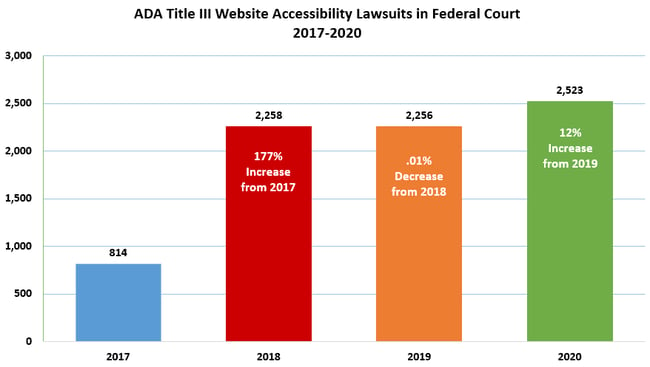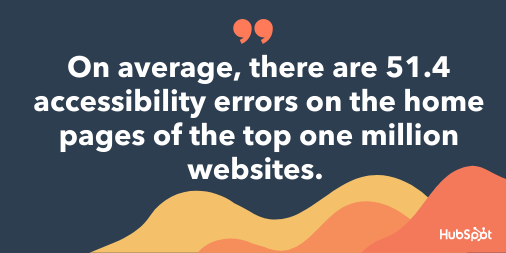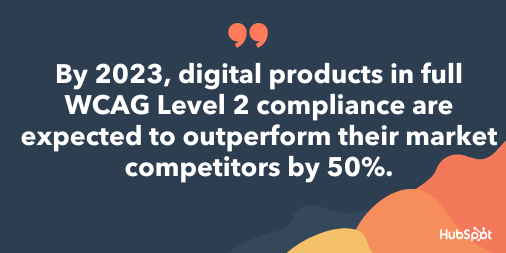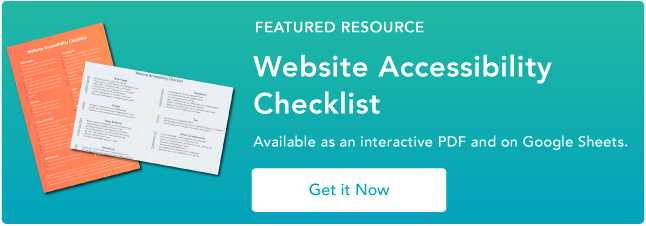Paul Smyth, Head of Digital Accessibility at Barclays, believes there’s a business case for website accessibility. In a recent webinar with AbilityNet, he said it boils down to three things: “the legal requirements, the commercial opportunity, and the moral imperative.”

 In other words, prioritizing web accessibility is not only the right thing to do — it can also reduce legal risks, strengthen brand identity, improve customer experience, and boost employee productivity.
In other words, prioritizing web accessibility is not only the right thing to do — it can also reduce legal risks, strengthen brand identity, improve customer experience, and boost employee productivity.
Website accessibility matters for a multitude of reasons — but many organizations are still falling behind Web Content Accessibility Guidelines (WCAG) conformance. To emphasize the importance of achieving conformance, we've gathered statistics that show how accessibility benefits millions of online users, why organizations implement accessibility, and what the most commonly detected accessibility errors are, among other important facts. Let’s get started.
- General Accessibility Statistics
- Website Accessibility Statistics
- Website Accessibility Testing Statistics
.png)
Website Accessibility Checklist
This checklist will help you make the following more accessible on your website:
- Web Pages
- Navigation
- Video & Media
- And More!
Accessibility Statistics
General Accessibility Statistics
- An estimated 1.3 billion people – or 1 in 6 people worldwide – experience significant disability. (World Health Organization, 2022)
- Globally, the market that includes people with disabilities as well as their family, friends, and advocates are estimated to control over $13 trillion in annual disposable income. (The Return on Disability Group, 2020)
- 75% of Americans with disabilities report using the internet on a daily basis. (Pew Research Center, 2021)
- In 2020, over 2,500 Americans with Disabilities Act (ADA) Title III website accessibility lawsuits filed in federal courts. This represented a 12% increase from 2019. (Seyfarth, 2021)

- 62% of U.S. adults with a disability say they own a desktop or laptop computer, compared with 81% of those without a disability. (Pew Research Center, 2021)
- 72% of U.S. adults with a disability say they own a desktop or laptop computer, compared with 88% of those without a disability. (Pew Research Center, 2021)
Website Accessibility Statistics
- In a study of the home pages for the top 1,000,000 web sites, over 51 million distinct accessibility errors were detected. This is an average of 51.4 errors per home page. (WebAIM, 2021)

- 86.4% of home pages have low contrast text. Low contrast text, which falls below the WCAG 2 AA thresholds, is the most commonly-detected accessibility issue. (WebAIM, 2021)
- 26% of images on home pages had missing alt text. (WebAIM, 2021)
- On average, a home page has nearly 48 ARIA attributes. This marks a 25% year over year increase in ARIA code usage. (WebAIM, 2021)
- Shopping sites decreased from 90.5 detected accessibility errors in 2020 to 75.2 errors in 2021, on average. However, this category remains among the least accessible, with 46.4% more errors than the average home page. (WebAIM, 2021)
- In an analysis of over 30,000 websites, Tenon found an average of 110 accessibility errors per page. (Tenon, 2021)
- In a survey of web accessibility practitioners, only 52.6% of respondents indicated that their own organization's web products were accessible in 2021, a decline from 63.1% in 2018. (WebAIM, 2021)
- 38.6% of employees reported that their product’s level of accessibility was called out as a reason for purchase by customers. (LevelAccess, 2021)
- Digital products in full Web Content Accessibility Guidelines (WCAG) Level 2 compliance are expected to outperform their market competitors by 50% by 2023. (Gartner, 2020).

- 89.1% of web accessibility practitioners indicated that better web sites would have a bigger impact on accessibility than better assistive technology and browsers in 2021. This is an increase from 83.1% in 2018, showing that practitioners have placed additional responsibility on websites over time. (WebAIM, 2021)
- 25.3% of web accessibility practitioners indicate that their organization's motivation for implementing accessibility is morals (ie. it's the right thing to do). 14.2% indicate that it’s a competitive advantage. (WebAIM, 2021)
- In a survey of 1,083 participants by LevelAccess, 61.7% answered that providing the best UX for all users was among the top three reasons their organization was addressing accessibility. (LevelAccess, 2021)
- According to an automated accessibility audit of the corporate websites of the Fortune 100, 815,600 WCAG 2.1 accessibility issues were identified, with the majority being Level A issues. This shows that Fortune 100 companies are failing to meet basic criteria for accessibility compliance. (Ovum, 2019)
- In a survey by Nucleus Research and Deque Systems, 70% of websites, ranging from top ecommerce sites to presidential campaign sites, had critical accessibility blockers. (Nucleus Research, 2019)
- Approximately 42% of people with disabilities think that web content accessibility has not changed over the previous year. (WebAIM, 2021)

Website Accessibility Testing Statistics
- 64.1% of web accessibility practitioners most commonly use aXe or aXe plugins for testing web accessibility. (WebAIM, 2021)
- Only 17.6% of web accessibility practitioners indicate that 50% or more of accessibility issues can be detected by automated testing. (WebAIM, 2021)
- In a study by Deque, 57.38% of total accessibility issues were detected using automated tests. However, while automated testing can detect the majority of errors, it can only detect certain types. For Deque’s technology specifically, it can detect issues for 16 out of the 50 Success Criteria under WCAG 2.1 Level AA. (Deque, 2021).
- 67% of web accessibility practitioners rate web accessibility overlays, plugins, or widgets that automate accessibility changes in web pages as not at all or not very effective. (WebAIM, 2021)
- As of 2022 the most common web accessibility error encountered on web pages accounts for 83% of web pages that contain text with low contrast. (WebAIM, 2022)
The Future of Web Accessibility
Accessible websites are better for everyone, including those with and without disabilities. Since the number of people experiencing some form of disability is expected to grow, organizations can expect more guidelines, legislation, and incentive to accommodate all users. Otherwise, their competitors will.









![Best Fonts for Accessibility and Visually Impaired Users [ADA-Compliant Fonts]](https://blog.hubspot.com/hubfs/ada-fonts.jpg)
![10 Most Common Website Accessibility Issues [+Examples]](https://blog.hubspot.com/hubfs/accessibility%20issues%20.jpg)